V-Shape vs I-Shape Ladder Stand-Off: Which One Fits Your Work Best?
Working safely at height always requires the right gear. One of the most important accessories for extension ladders is the ladder stand-off (also called a ladder stay). These attachments help you keep the ladder clear from gutters, windows, or edges, increase lateral stability, and make working next to walls or corners safer.
But not all stand-offs are the same. Two of the most common designs are I-Shape and V-Shape ladder stand-offs. Which one is better depends on your work environment, the types of surfaces you work against, and the demands of your tasks.
In this article, we compare V-Shape versus I-Shape stand-offs in detail and show how I-Shape Aluminium Ladder Stand-Off and Universal V-Shape Aluminium Ladder Stand-Off stack up in performance.
What Are I-Shape and V-Shape Ladder Stand-Offs?
Before diving into pros and cons, it helps to understand what each design looks like and how it functions in practice.
- I-Shape Stand-Off: This type mounts in a straight, horizontal bar extending from the ladder. It keeps the ladder away from walls, providing clearance. Its design is ideal for working against flat wall surfaces, siding, or gutters.
- V-Shape Stand-Off: This design features a “V” or angled shape that can straddle corners, downpipes, or gutter edges. The V-shape allows the ladder to rest on both sides of an obstruction, giving more flexibility in awkward architectural situations.
Because of these geometry differences, each design has strengths in particular use cases.
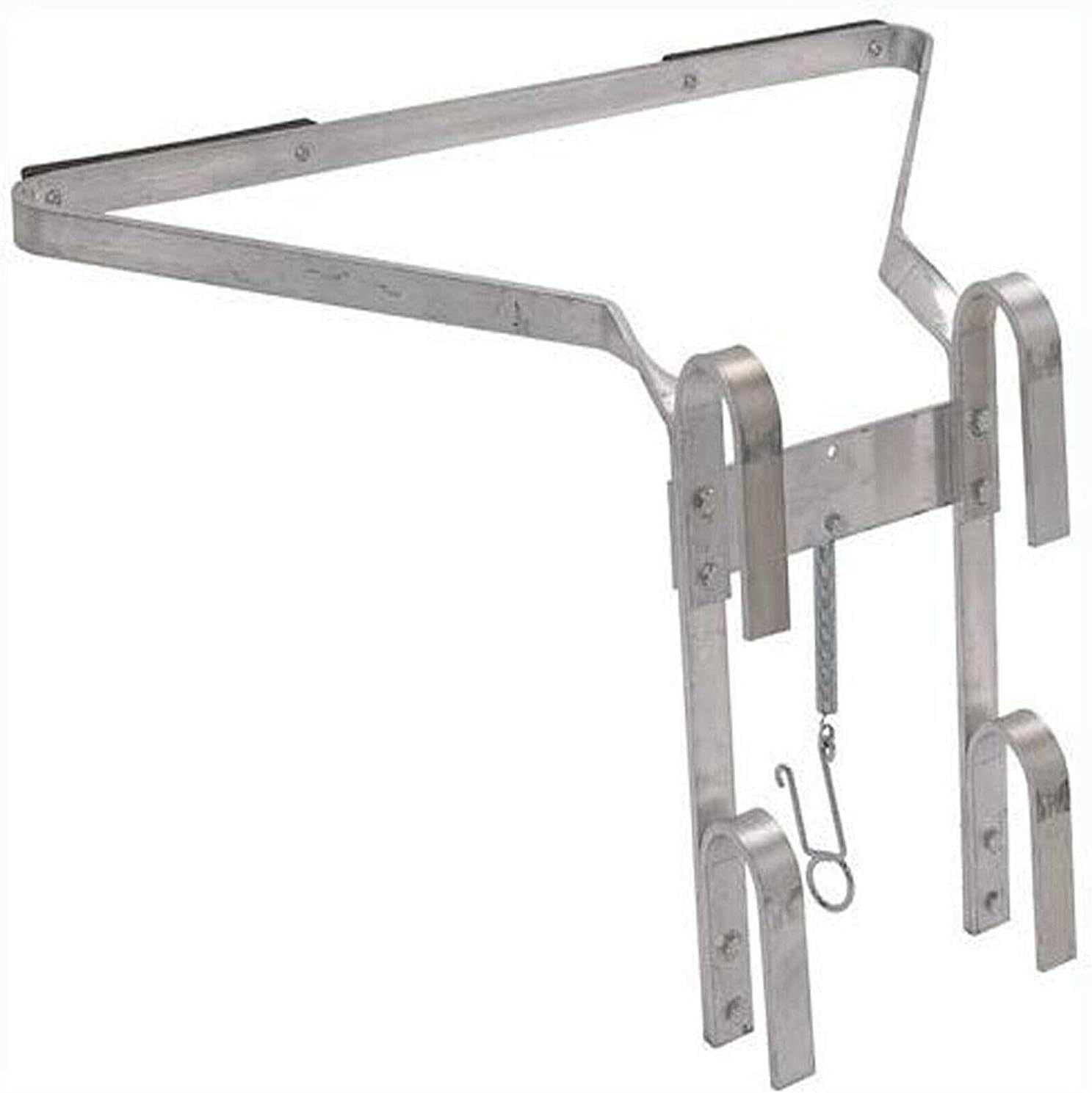
I-Shape Aluminium Ladder Stand-Off — £20.00
Key Differences: V-Shape vs I-Shape Ladder Stand-Offs
While both V-Shape and I-Shape ladder stand-offs are designed to enhance ladder stability and safety, the difference lies in how they perform across different job conditions. Understanding these distinctions helps you choose the right tool for each task, ensuring not just stability but also precision and safety during work at height.
Wall vs Corner Use
The biggest difference between the two designs comes down to where and how they make contact with the surface.
- I-Shape Stand-Offs:
These are built with a straight horizontal bar that positions your ladder evenly against flat surfaces like walls, fascia boards, and cladding. The ladder rails stay clear of gutters and paintwork, reducing the risk of damage.
Ideal for general maintenance, window cleaning, or painting jobs on flat exteriors, the I-Shape gives uniform clearance and ensures that the ladder stays parallel to the surface.
- V-Shape Stand-Offs:
The V-shaped design comes into its own when working around corners, downpipes, or irregular structures. Instead of sitting flush, it grips two points on either side of an obstruction, allowing you to “bridge” pipes or corner edges safely.
For example, when cleaning gutters where rainwater pipes run vertically down the wall, a V-Shape stand-off lets you position the ladder right in front of the pipe without leaning awkwardly to one side.
Clarity and Reach into Obstructions
Each design offers different levels of accessibility depending on the environment:
- I-Shape Stand-Offs:
Because they push the ladder away from the surface, you get a wide, clear working area perfect for reaching into gutters, overhangs, and flat facades. However, if there’s a pipe or external wiring, the straight design can limit how close you can get to the target area.
- V-Shape Stand-Offs:
By comparison, the V-Shape gives you freedom to work directly in front of obstacles. Its contoured arms make space for downpipes, window frames, or external fittings, enabling you to stay centred while maintaining ladder balance. This added flexibility reduces fatigue, since you don’t have to stretch or reposition repeatedly to reach narrow areas.
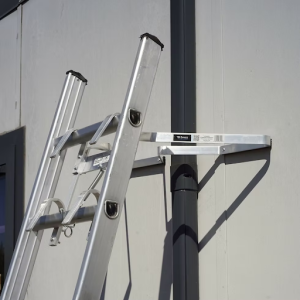
Lateral Stability
Both stand-offs improve ladder stability compared to leaning directly against a wall but they do so differently.
- I-Shape:
Offers a broad, symmetrical footprint that increases side-to-side stability when working against flat walls. The horizontal bar spreads contact evenly, distributing weight and pressure across both rubber ends. This makes it ideal for steady, repetitive work like sanding, painting, or inspection.
- V-Shape:
Matches the I-Shape in overall stability but performs better where the surface isn’t even or when you’re forced to rest on corners. Because the two angled arms grip independently, they prevent lateral slip even when only one side makes full contact at a time, for example, when positioning over a narrow corner or gutter edge.
Also, check out How to Use a Ladder Stand-Off Safely?
Ease of Use & Setup
Simplicity can be the deciding factor when you’re on-site all day.
- I-Shape Stand-Offs:
Typically quicker to attach and remove, these are a “plug-and-play” solution. You hook them over the ladder rungs, tighten the clips or springs, and you’re ready to go. Their straightforward design means minimal adjustment once fitted.
- V-Shape Stand-Offs:
Take slightly longer to position because you often need to align the arms correctly over a corner or pipe. However, once secured, they save considerable time by eliminating the need to reposition the ladder around every obstacle. For multi-surface jobs (like window installers or guttering specialists), the setup time quickly pays off.
Weight and Bulk
Portability is key for tradespeople who move frequently between sites.
- Both V-Shape and I-Shape stand-offs are usually made from lightweight aluminium, striking a balance between strength and easy handling. Aluminium doesn’t corrode, making it a practical choice for outdoor work.
- The I-Shape design is often slightly lighter and slimmer, which helps when carrying the ladder through tight spaces.
- The V-Shape can be a bit bulkier due to its angled arms, but this added structure is what gives it versatility around complex surfaces.
Surface Protection and Grip
No matter which shape you choose, the contact points must protect the surface while keeping the ladder secure.
- Both V-Shape and I-Shape stand-offs are fitted with anti-slip rubber pads to prevent scratches on paintwork or gutters. These pads provide grip even on damp or smooth surfaces, which is vital for outdoor work.
- The I-Shape’s horizontal pads distribute weight evenly, reducing pressure marks on delicate surfaces.
- The V-Shape’s angled grips make dual-point contact, ensuring both sides of a corner are supported evenly, even if the wall texture varies.
When choosing your stand-off, inspecting the rubber ends regularly worn pads can compromise grip and stability over time.
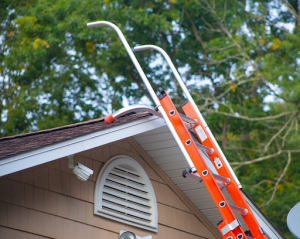
Durability and Longevity
Both designs depend heavily on build quality. A poorly made stand-off can bend or deform, affecting ladder balance.
- Kirmell manufactures all ladder stand-offs from high-grade aluminium, which combines corrosion resistance with rigid structural strength. This ensures that even under repeated use or exposure to the elements, the frame remains straight and true.
- Reinforced joints and spring-loaded clips improve safety by locking securely into place, keeping the ladder steady while you climb or work.
Investing in a quality stand-off means you’ll replace equipment less often and maintain consistent safety standards across every job. Also see How Ladder Stand Offs Improve Safety When Working at Height.
When to Choose I-Shape
I-Shape stand-offs are a solid, reliable choice when your ladder is going to rest against flat surfaces (brick, siding, masonry). If your tasks involve gutter cleaning, window washing, or work against flush walls without many obstructions, I-Shape is often easier to use and quicker to mount.
When to Choose V-Shape
If you regularly work around corners, downpipes, protruding architectural features, the V-Shape becomes highly valuable. It allows you to straddle the obstruction instead of trying to maneuver around it. It’s often preferred in gutter cleaning, facia and soffit work, and buildings with rainwater pipes or awkward ledges.
Installation Tips for Both Types
- Attach the stand-off at ladder ground level before extending upward.
- Ensure rubber pads are flush against surfaces for grip.
- Check locking springs or clips are secure before climbing.
- Avoid overextending and maintain a safe angle.
- Inspect the stand-off after use and look for bent corners, cracked pads, or misalignment.
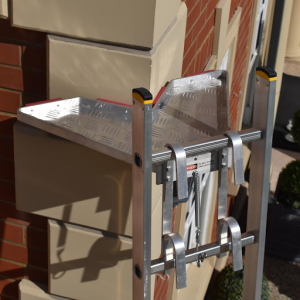
Combining Usage: Flexibility in the Field
Some professionals carry both types. That way, when they approach a flat wall, they use the I-Shape, and for the next section near a downpipe or corner, they switch to the V-Shape. Kirmell’s products, being lightweight and quick to attach, make this approach more practical.
Why Choose Kirmell Ladder Stand-Offs?
When it comes to working at height, safety and stability can’t be left to chance. That’s why choosing high-quality, precision-engineered accessories matters. At Kirmell Ltd, we manufacture durable, UK-made aluminium ladder stand-offs that deliver reliability and performance for professional use.
Our range includes the I-Shape Aluminium Ladder Stand-Off, designed for stable wall work, and the Universal V-Shape Aluminium Ladder Stand-Off, ideal for corners, gutters, and downpipes. Both models feature lightweight yet strong aluminium construction, anti-slip rubber grips, and universal ladder compatibility ensuring you can work confidently in any environment.
Whether you’re a contractor, roofer, painter, or maintenance professional, Kirmell stand-offs are built to make your job safer and more efficient. Explore our ladder stand-off products today and experience the precision of British manufacturing trusted since 1985.
Conclusion
The I-Shape stand-off is best when your main focus is efficiency and simplicity for wall work. It’s compact, lightweight, and ideal for everyday trade applications where surfaces are flat.
The V-Shape stand-off, however, is the smarter option for complex structures, corners, pipes, or multi-level surfaces. Its design offers more adaptability, which makes it a favourite for roofers, painters, and maintenance professionals working on diverse building types. Whichever you choose, Kirmell’s British-made aluminium ladder stand-offs provide reliability, strength, and safety, helping professionals work smarter and safer at any height.
FAQs
How do ladder stand-offs improve safety when working at height?
When should you use a V-Shape ladder stand-off instead of an I-Shape?
Where can I buy Kirmell ladder stand-offs?
Do Kirmell offer trade or bulk pricing?
Do Kirmell ladder stand-offs come with a warranty?

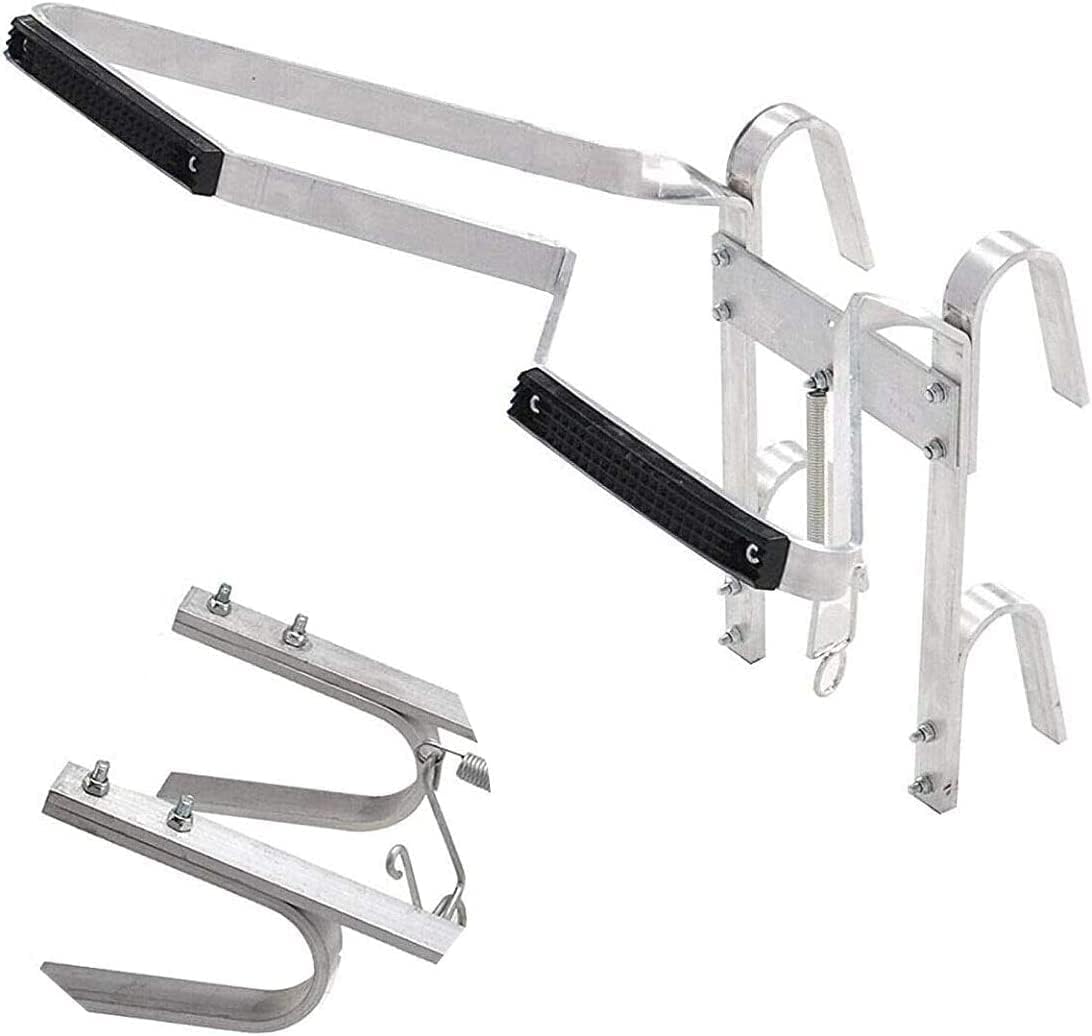



Leave a Reply
Want to join the discussion?Feel free to contribute!